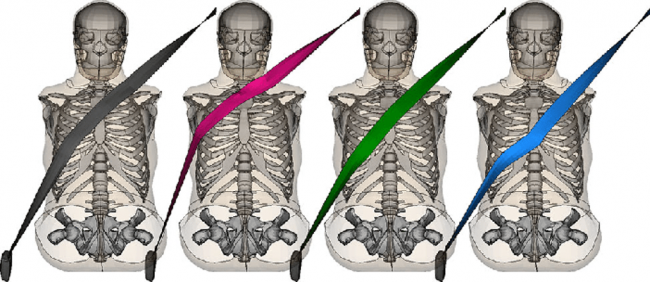Welcome to Karl-Johan Larsson's Doctoral Thesis defence: ": Human Body Model Morphing for Assessment of Crash Rib Fracture Risk for the Population of Car Occupants"
Karl-Johan Larsson is an industrial doctoral student from Autoliv and the Division of Vehicle Safety, Department of Mechanics and Maritime Sciences at Chalmers University of Technology. Karl-Johan’s work was made possible by the SAFER associated projects Assessment of Passenger Safety in Future Cars and Car Passenger Safety – to the next level, both sponsored by Vinnova within the FFI program.
Opponent: F. Scott Gayzik (Associate Professor, Biomedical Engineering, Wake Forest Center for Injury Biomechanics)
The grading committee includes:
Bingbing Nie (Associate Professor; Tsinghua University)
Dan Högberg (Professor; University of Skövde)
Jac Wismans (Professor Emeritus; Safeteq)
Martin Fagerström (Professor; Chalmers)
Examiner: Mats Svensson (Professor; Chalmers)
Main supervisor: Bengt Pipkorn (Adj. Professor; Chalmers)
Co-supervisor: Johan Iraeus (Researcher; Chalmers)
Abstract
Fractured ribs are prevalent injury outcomes for vehicle occupants involved in crashes. Sex, age, and anthropometry of an occupant influences the risk to sustain rib fractures. The SAFER human body model (SHBM) represents an average sized male and includes a detailed ribcage model that has been validated for prediction of rib fracture risk in virtual crash simulations. Developments in parametric morphing of human body models have enabled re-shaping the SHBM to represent a wide range of body sizes for both adult males and females which can influence kinematic and injury risk predictions. The aim for this thesis was to enable the assessment of crash kinematics and rib fracture risk for the population of occupants by morphing the SHBM. Research was performed within objectives that included: providing a definition of the occupant population, creating morphed versions of the SHBM (MHBMs) and validating MHBM crash kinematic and rib fracture risk predictions within the defined population, develop a method to efficiently compute rib fracture risk across the population, and investigate factors beyond morphing that influences MHBM rib fracture risk predictions. The population definition includes 90 % of the U.S.-population in terms of male and female height and weight variability. For validation, parametric morphing was used to create MHBMs geometrically matching age, sex, height, and weight of 22 human subjects in previous crash tests. Rib fracture risk and kinematic predictions from MHBMs were validated by comparison to test results and MHBMs showed good correlation for kinematics and had acceptable utility to predict rib fracture outcomes. However, the rib fracture risk for the most vulnerable, predominantly older, occupants was underestimated. One reason can be rib cortical bone microstructural defects, that are not represented by current SHBM rib material modeling. To compute population rib fracture risk in crashes, a metamodeling method based on 25 differently sized MHBMs of each sex was recommended. Using this metamodeling, method it was also identified that seven selected MHBMs of each sex can be used to predict the population risk across two specific crash scenarios. This indicates a possibility to identify a small family of MHBMs that are generally representative of population rib fracture risk in future work. For further improving rib fracture risk predictions, a new rib fracture risk function was developed based on human rib test results. The new function is more sensitive to age compared to previous risk functions. Additionally, it was identified that the individual variability in rib cross-sectional width, as well as cortical bone thickness and material properties all substantially influence rib fracture risk predictions. Including the individual variability in these influential parameters in MHBM models will improve the capability of MHBMs to predict the rib fracture risk variability that exists in the population of occupants independently of sex, height, and weight. It is concluded that MHBMs representing geometrical shape trends due to height, weight and sex, and individual rib local variability can be used to assess kinematics and rib fracture risk for wide range of males and females of different sizes. However, more research is needed to accurately predict the risk for the most vulnerable, predominantly older occupants.

